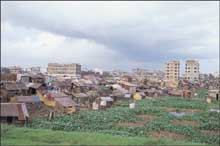|
|
|
|
|
|
|
|

Case study: Dhaka - Part 2
70% of the city's slum dwellers do not have access to safe drinking water. In one area, local leaders identified and organised every five households to form a group; and 20 - 30 groups formed one community, known as a samity, that would become the location of a water point. Community building exercises enabled the formation of a group which drew up a plan covering costs of building, managing and maintaining the water point. Given a loan from a national NGO, discussions with the Dhaka Water Supply and Sewerage Authority and the Dhaka City Corporation cleared the way to provide a road, construct the water point and lay pipes. The samity charged households to ensure that there was money to repay the loan and employ part-time caretakers to collect the water rates and maintain the water point. Community development work began with education, recognising that future economic progress is dependent upon raising the low status of women. Many migrants to Dhaka are lured by the possibility of more available schooling - for boys. City authorities are encouraging families to send girls also, until recently seen as a waste of time. Within community building programmes, the importance of education for girls and women is stressed as a way of gradually improving the standard of living of the family. At present, families rely heavily on the income they receive from their children and many in the bustees do not receive any formal education at all. Rather than ban all children from paid employment, agencies are trying to improve conditions for them in the workplace. The Dhaka Sahnsamia Mission has set up schools in the Dhaka shantytowns that these children can attend for about three hours every morning before going on to work.
|

